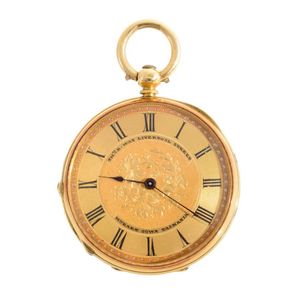Gold Pocket Watch with Repeater and Duplex Movement
You must be a subscriber, and be logged in to view price and dealer details.
Subscribe Now to view actual auction price for this item
When you subscribe, you have the option of setting the currency in which to display prices to $Au, $US, $NZ or Stg.
- Movement - The technical name for the workings of a clock or watch, and does not include the dial or case.
- Engine Turned - Engine turning is a decorative technique used on metal surfaces to create intricate curving or geometric pattern. The process involves cutting a series of lines into the surface of the metal using a rose engine or decoration lathe which rotates the metal as it cuts, allowing the operator to create a repeating pattern that covers the entire surface. The resulting surface has a shimmering, reflective quality that is often described as "engine turned." Where an engine turned item has been enamelled, the term used to describe the decoration is usually guilloche.
Engine turning was originally developed to decorate metal objects such as firearms, scientific instruments, and other metal objects that required precise and elegant design. - Fusee - The fusee movement was used in clocks and pocket watches from the mid 17th century. The fusee is a cone shaped drum within the works that is linked to the barrel of the spring, usually by a length of chain.
As the mainspring loses its tension over time, the cone shaped barrel compensates for this by increasing the tension, by pulling the mainspring tighter, thus ensuring the time remains constant.
Use of the fusee in clocks was superseded by the "going barrel" in the mid 19th century and for pocket watches at the beginning of the 19th century.
The fusee continued to be used in marine chronometers until the 1970s.
This item has been included into following indexes:
Visually similar items

A keyless Swiss 18ct gold open face pocket watch, stamped 18K and made for Stewart Dawson, c.1900. Rolled gold bow. Lever movement 3/4 plate. Diameter 51 mm. TW 96.4gms.

A rare early antique Australian ladies open face gold pocket watch, key wind and set movement, circular gold dial with Roman numerals, signed dial, movement and curvet, Thos. B. Way Liverpool Street Hobart Town Tasmania, case signed G. Chopard, 18ct gold c

A gold open face pocket watch, Purportedly gifted to Frank Rigo from Dame Nellie Melba, circa 1911, crown wind movement, circular silvered dial with Roman numerals, 18ct gold case, engraved lid with the initials 'F.R.' and further hand engraving to the inn

A Waltham rolled gold open face pocket watch, white enamel dial, Roman numerals, subsidiary seconds on a stem wind and set plate movement signed A.W.W.Co. Waltham Mass. Size 50 mm. C 1898.
